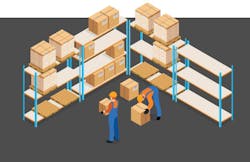Larry Brown, owner of Davis Repair in Greenwood Village, Colo., says that two of his favorite things are numbers and parts. Most of Brown’s career, including a 20-year stint at NAPA, has involved these two things. Before purchasing the shop in 2008, Brown was a parts specialist and worked with shops to fix their parts inventory.
“Inventory and parts are half of your business,” Brown says. “If you pay attention to labor, and not to parts, you’re going to lose money. You have to give it equal attention.”
When Brown took over the shop, he stressed the importance of tracking cores to his staff. With a dollar amount ranging anywhere from $20 to hundreds of dollars, forgetting about cores can quickly add up.
“If you don’t get credit, there are certain cores that can be $200,” Brown says. “That can be a real drain on your gross profit.”
Brown, who boasts a core return rate close to 100 percent, is in the process of starting a company where shop owners can sell parts that cannot be returned. Here, he breaks down his process for tracking cores and returns to ensure he doesn’t lose money.
When our parts get here, we have a designated area where the part is placed and the service advisor signs for it. We use R.O. Writer and add the part on the invoice and put the part number into the system. Once the part is entered into the system, the part is taken back to the tech.
When I came on board, the staff put cores in one area to be returned. We still do that, but now there is a specific area for each vendor, and I’ve made sure that my techs know the basics about what has a core and what doesn’t. Sometimes, you don’t always know unless you look at the invoice. Certain things are always cores. There are several ways to tell. It will always say on the parts invoice if there’s a core. If there is a core, the technician will bring the core back up in the box. If it’s not in the box, suppliers may not give credit.
If a part is wrong, the tech will bring it up and it will go into the return bin. The supplier will come by and pick up any returns and write them all down and write out a return slip that we put in with the invoice. Each supplier has a separate file and the return slips and invoices go into the folder.
Once a core has been placed in the designated area and the vendor comes to collect, we get a return slip from them and compare the return slip to the credit to verify that the cost is correct. If there’s a quantity of, say, six spark plugs, we make sure that there are six and then verify that the price is correct. Then, it can be checked off the return slip.
At the end of the month, we gather up all of the invoices and look for all of the credits and match those up with the return slip. If, for whatever reason, we don’t have an invoice, we call and get a copy from the supplier.
When it comes to cores, I think one area that many struggle with is dealer parts. Dealer parts can build up. If you don’t call the dealer and let them know, they’ll never come pick the parts up. They’re not like independent aftermarket stores. Some dealers will require an invoice copy. The key is staying on top of this all of the time and making sure that core parts from dealers are tracked every day. Sometimes, it takes dealers up to a week to get their returns, so I just do it myself.
We are always looking at our return bin. It’s critical to get all of the returns before the end of the month so you don’t have to pay for them and wait to get credit. It has to be a priority—it’s real dollars.
Everyone has a different process for managing their inventory. However, it’s something that you need to keep thinking about. You should make managing your inventory something that you’re constantly trying to improve.

